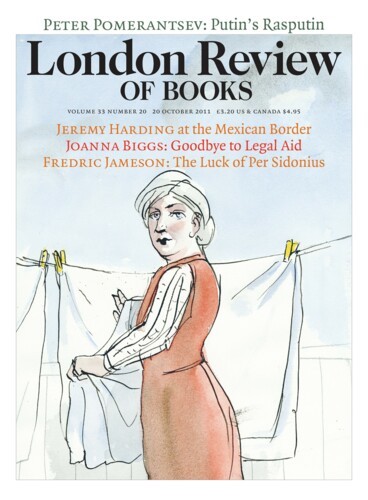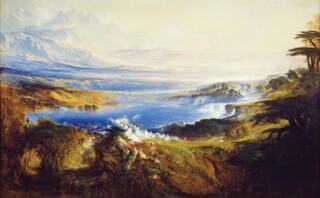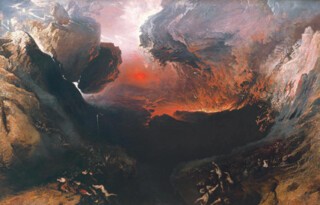I begin to write about John Martin: Apocalypse (at Tate Britain until 15 January) before looking at the pictures. Maybe, I say to myself, if I set memories of Martin’s pictures against the words in the catalogue (Tate, £19.99), if I learn what he achieved in more than a century and a half of (variable) success, I’ll find that we owe his memory some kind of apology. Maybe, and maybe there are plenty of people who remember his work well enough, but isn’t it as something they scurried away from?
The catalogue provides a full, non-committal rundown on what he did, the palaeontology as well as the brimstone, the civil engineering as well as the images. So, first move: remind myself what there was. Paintings and engravings of biblical and classical histories, some of them very, very large; aquatints, technical triumphs of a kind (it was a great medium for storm and ash clouds); illustrations pointed up by human figures, often very, very small, given curiously slug-like silhouettes by dragging drapery. All these are played out against a glowing compost of theatrical hells and heavens: glistening cataracts, twisted forest trunks, cloud-stormed, city-topped outcrops, bleak mountain gullies. Heaven is distant and rather bright, its waters very blue. When it’s shown close up, herbaceous borders grow by placid waters. Cataclysms bring volcanic lava flows. Veils of pumice rain down thunderously in orange and pink on red. Very rigid white lightning pierces voluminous clouds. Complex architecture – fancies like Gandy’s more extravagant perspectives – tumbles down on you or billets the hordes of Milton’s Satan.
Take the measure of what he did from the catalogue and you are left with evidence of tremendous activity. He finished his life as he had begun it, a painter, but there was long, unrewarded, work on a new London water supply and sewage system that antedated (and influenced) Bazalgette. He made money but sometimes approached bankruptcy. In the exhibition there is a large ebonised cabinet to hold, among other things, all his medals and certificates. Not a man to dismiss for slackness.
If I still say it is clear he was a bad painter, I’m not being original. He was never one whose limitations were obscure. It wasn’t snobbery that motivated those who, from the first, found his success and the style that drove it questionable. Critics wrote about the ‘struggle after mere effect’. Martin Myrone’s introduction points out that Hazlitt and Constable, among others saw in Martin’s work ‘a false understanding of the principles of the Sublime’. Popular writers treated him more kindly. But while Bulwer-Lytton called him ‘the greatest, the most lofty, the most original genius of the age’, a review in the Edinburgh Literary Journal found that ‘all Martin’s productions are rather imposing at first sight and when more closely examined something very like a piece of humbug.’
So it is time to sort things out, to visit the work in the flesh. Best start almost at the end with the Last Judgment Triptych – The Last Judgment, The Great Day of His Wrath and The Plains of Heaven (1845–53) – the second and third of which are reproduced here. These are hung in a long dark hall (hell-fire sermons, preached visually or verbally, resonate best in large spaces); a preacher’s voiceover describes the torment and bliss they illustrate, but there is thunder too, if I remember rightly, and startling effects as bits of one picture after another are lit by lurid, projected light. Then the main lights come up and you can have a proper look at the artwork. This attempt to re-create the atmosphere of the triptych’s life as a travelling show is suitably brash. Leave this gallery, go back to the beginning and take a quiet, high-art look knowing that the low-art core of the show, the theatrical, preaching aspect of it, is to follow.
Martin’s impact, made by the prints he sold, the crowded exhibitions, the world tours, produced a reputation that was not sustainable. His influence has survived mainly in the extravagance of disaster movies, but not only there. Glenn Brown’s reworking of The Great Day of His Wrath as The Tragic Conversion of Salvador Dalí is the last picture in the exhibition; the catalogue reproduces a poster for the disaster movie 2012 and a still from a computer game, Hellgate: London. Martin the serious entrepreneur would have liked to have held his own as a visionary. But his designs for the reconstruction of London’s sewers are not something Blake or Turner would have taken on.
The directors of our own cultural establishments have not given up the notion that there is a place for gatekeepers, but they are more curious and less severe than the directors of the Royal Academy were in Martin’s day. They need the crowds that have filled the Turbine Hall, but wish the sun, the sunflower seeds, the murmuring walls, the crack in the floor to be more than curious sideshows. But even these huge installations cannot match Martin’s biblical enthusiasm. The public, which can no longer look for common standards of taste, high craft and skill, is left interpreting a very mixed set of signals; that any bedrock exists at all is without doubt an illusion – new schools and styles build on the rubble of old ones. But those pieces of breccia can mark out territories on which it is possible to feel that judgment is more than the exceptional acuity of individual critics or canny dealers.
Does an audience that can affirm the excellence of Martin’s populism exist any more? Could anyone believe that the sublime can again serve as a subject for representational art? We can only laugh now, or sigh at the all too possible end of the world. Compared with Turner’s, Martin’s sublime was vulgarly overstated: the buildings are too big, the fires and lava flows too bright. The paint in both may have depicted the might of rough nature, but Martin’s is garish. It is as though he was preparing a travel agent’s advertisement: ‘Join Heaven and Hell Tours for the thrill of a lifetime.’
Send Letters To:
The Editor
London Review of Books,
28 Little Russell Street
London, WC1A 2HN
letters@lrb.co.uk
Please include name, address, and a telephone number.



